A
Revolutionary Healing Science - the laws
of pain - Exposes Hypocrisies
in
Religion, Science, and Government
by Raymond Lane
Throughout history, society has been ruled by three primary
influences: religion, science, and government. Today they still
influence our beliefs,
thinking, and actions via preachings, research, and laws respectively.
These organisations provide valuable services for people, including
treatment for health and behavioural
problems. And they have all contributed excellent
achievements to the fabric of society, especially in improving
education, physical health, and
working conditions respectively. But such achievements were not arrived
at
smoothly – often necessitating revolutionary movements to bring them
about against repressive social regimes within each discipline.
Additionally, they are all yesterday's achievements, and they have only
resolved the most prominent aspects of human suffering – like
illiteracy, major diseases, and
poverty. The current crop of human health problems – like headaches,
migraines, autism, epilepsy, and mental
illnesses; and behavioural problems, like alcoholism, violence, and
drug addiction – are not being healed, only managed or coped with.
Now, however, a revolutionary new development – the laws of pain,
which
resolves past traumas – can point out hypocrisies in this current
ruling
system, provide a new direction for more effective healing, and make
further improvements to human life. But ruling organisations do not
always take kindly to new developments. In this case, they generally
accept that bad experiences in early years can negatively
affect
people as adults. But they do not believe that "past traumas" are still
active inside of us, or are an ongoing source of suffering, or that
they could be reaccessed and their negative effects resolved. They
either claim that the "past trauma" paradigm does not exist, or they
try to ignore
it – and, hence,
also try to ignore the laws of pain.
This
article is about how
religion, science, and government (which supports the former two) are
using
information
related to those laws to try to help promote their own, older
explanations for
human suffering, that goes counter to their claims. (Internet
images
are included in this article for informational purposes.)
The laws of
pain (LOP)
The laws of pain system (also
known as Superpsychology) is a science concerning human suffering,
human evolution, and the nature of the
universe. The three laws of pain
(or LOP) can be summed up as follows:
- Individuals
suffer from a history of unresolved psychoemotional traumas (to varying
degrees).
- The human
species suffers from a history of unresolved social
traumas – that caused it to develop into a superorganism structure.
- The
universe is a superstructured entity – that is, it displays the
same characteristics as a superorganism (or hologram, or fractal).
The laws
of pain can be used
separately, or together – whereupon they
form a formula that underpins organic structures in nature. In essence,
what applies to one law, also applies to any of the other laws. This
formula can be summed up as follows: large structures
in the universe reflect small structures, and vice versa.
Religion,
Science, and Government have already partially recognised the effects
of past traumas
Unresolved past
traumas are a constant presence in those affected, and
cause them to act out and also develop niggling health and behavioural
problems. So it is not surprising that religion, science, and
government have, from time-to-time, already noted the effects that past
traumas have on people (but without fully
understanding the
phenomenon). Below are some examples.
Science
has recognised the effects of past traumas in People
The development of drugs that work on the brain has been
instrumental in uncovering past trauma.
Medical
personnel used drugs to treat WWII soldiers suffering from shell
shock – or battle fatigue. They noted that
some of the soldiers reported that they
were reexperencing their births.
In medical literature there is a reference to a sensation of a tight
band
around the head accompanying tension headaches. This, again, is related
to birth trauma - specifically crowning pain.
“An
episodic tension headache may be described as a mild to moderate
constant band-like pain, tightness, or pressure around the forehead or
back of the head and neck...The pain is usually throbbing... About
30%-80% of the adult U.S. population suffers from occasional tension
headaches...” [1]
Medical researchers have recently noted that 80% of first-time mothers
who have
previously experienced (adult) rape, have greater difficulty with
births compared to first-time mothers who never experienced rape:
"The
study shows that women who have been raped stop having strong
contractions towards the end of the delivery process. It appears
that common medical techniques and procedures that are used during
childbirth may reawaken the trauma of rape. The trauma may be
reactivated when the woman is on her back and is undressed. She is
surrounded by strangers who are 'having their way' with her
body. 'It is not hard to imagine that this can awaken memories
of the assault,'... Those who have been abused are more
vulnerable. 'Their experiences have been suppressed, but come
forward during the birth,'..." [2]
Religion
has noted the symptoms of tension in their followers
Religious people who feel that they are suffering go to their
church for help.
In
the 2002 National Geographic documentary, Inside the Vatican, the Pope's
exorcist stated
that most people that come to him for help are not possessed by the
devil
but are suffering from tension. So he advises them to seek counseling. [3]
Government
has noted the effects of severe trauma in people
Since
governments represent the people, they
do notice some degree of psychoemotional suffering in the populace.
There
is a government department dedicated to providing care for children
at risk in troubled homes (such as from malnutrition, violence, sexual
abuse, or death). And, globally, they recognise oppressive regimes that
cause undue suffering to their peoples. They also recognise basic human
rights such as freedoms in speech, travel, and religious belief.
Such
examples of suffering recognition are patchy, however, and do not
normally relate
to everyday life. They only relate to an effect of one trauma, or a
general
symptom of suffering, or (in the government's case) only the most
prominent (physical) traumas. Additionally, they are seen as traumas
occurring to
people from an adult's perspective, in an adult-orientated world.
There is no
recognition of psychoemotional suffering accumulating throughout
upbringing – from birth and infancy, to childhood, then to schoolyears,
and on to early adulthood – that can occur within seemingly innocuous
institutions like the average family home, school, university, or
workplace. There is also no recognition that trauma-related health and
behavioural problems can be passed on from generation to generation.
Scientific
Studies supporting adverse effects of past traumas
A search of any
science archive can bring up numerous research studies showing the
long-term adverse effects that early life traumas have on people. Early
traumas have been linked to later onset of obesity, arthritis,
migraines, schizophrenia, PTSD, and bullying. Even adverse birth
presentations have been linked to later health problems. Recently, the
focus
has moved to life in the womb and its effects on later health and
behavioural problems. So why hasn't
religion, science, and government acted upon these
findings to provide a social environment dedicated to the healing of
past
traumas? Nothing has been done because the purpose of most research
studies – especially in the field of health care – is to establish
whether an effect exists or not. So they are typically shallow – with
studies in the same research areas often producing conflicting results.
Take obesity for example; research studies have also shown that it is
linked to sugar, TV watching, snacking, and to a “fat gene”. So any
past trauma-supporting research tends to get drowned out by other
findings. Additionally,
research results are interpreted via a convoluted "worldview" involving
the genetics theory of
suffering. That is, that early life traumas lead to genetic faults (or,
now, epigenetic faults) – which then lead to
later health and
behavioural problems, which then require new pharmaceutical drugs to
treat.
Birth Trauma
One of the main
discoveries of the (first two) laws
of pain
is that
pain to the head caused to babies at birth is the biggest source of
health
and behavioural problems in the human species. This is not a
convolution
– it is a
psychotherapeutic discovery – made by directly
reaccessing and resolving birth trauma – and which can also
be supported by
evolutionary evidence.
Crowning images: [1] [2]
Due to our species'
evolution – involving an infection of unresolved trauma, followed by
meat eating,
technological development, and language – the human skull has become
oversized in relation to body size (neotenisation). Consequently, the
most difficult part of birth is the passage of the large foetal skull
through the narrow canal. The result is a lot of pressure and pain
caused to the baby's head. Part of this
experience is
commonly known as crowning (above images).
Crushing images: [1] [2]
During
birth passage the baby's head is compressed and molded. It can even be
partially crushed, with the skull plates held together
by cartilage (above images). The end result of birthing is that the
skull becomes
elongated (but assumes the normal
ovaloid shape a couple of days later).
So how is it possible to know that birth is painful? After a number of
years of reaccessing and resolving past traumas (known as exfeeling in
LOP) one takes a journey deeper and deeper into the past, and,
correspondingly, deeper and deeper into evolutionary brain structures.
Eventually, some strong pains start emerging – stronger than the pains
of later years. One of those pains
involves sensations of a tight band
around the head. This is unmistakably pain from crowning at birth.
As
this pain resurfaces it also produces strong psychological symptoms: a
nagging, buzzing sensation in the head, an obsession with doing one
thing or taking one course of action, and an inability to perform
multiple tasks – as too much mental input becomes overwhelming. These
are unmistakably symptoms of autism. But when this pain is fully
resolved the individual is able to function more normally once again –
able to do multiple tasks, and suffers less intense and less frequent
tension headaches. What does this tell us about crowning at birth? Intense or prolonged crowning pain is the
cause of tension headaches, neurosis that makes
some children backward or hypertense, as well as the multiple shades
of autism (Autism Spectrum Disorder) that retards some children's
mental development.
The laws of pain view is that
the totality of pains caused to
the head during birth is not only the source of the above problems, but
also
others, like migraines, epilepsy, and brain damage. And such unresolved
head trauma is also
implicated in health problems of later years, including stroke, heart
attack, Dementia, and others.
Psychology, psychiatry, and other forms of psychotherapy cannot heal
these kinds of obscure health problems (in socially functioning
people), because
of their genetics and cognitive bias. They incorrectly believe
that voluntary changes in thinking or behavioural patterns will resolve
deep-set
psychoemotional problems. Although there are some therapies that have
had success at getting a small number of children out of a stuck
autistic state – they usually work by extensive educational stimulus
(i.e., to make them more cognitively-functional).
In order to debunk the growing claims of being able to heal
suffering by reaccessing past traumas, science
has employed research
showing that people can be implanted with false memories, known as
“False Memory
Syndrome”. And they also like to highlight cases of patient abuse due
to poor practitioning (by fad therapists, who do not care to follow any
laws or proper treatment guidelines). So
in light of these vehement
objections, one must ask: what is a birth trauma-like image doing on
the front cover of a recent issue of a prominent science publication?
Before getting to that image, it needs to be put into context by going
back to the subject of our
reigning social organisations: religion, science, and government.
They
do not believe that babies suffer from any type of pain at birth. They
say that there is no research evidence
for this. But, then, they also do not even
consider
evidence from human evolution. And when we look back in time we can see
not only a history of head trauma in the general populace (as I have
shown in other articles), but also a
history in each of these three social organisations – the ones that are
supposed to be responsible for treating human suffering.
Historical
Evidence of Birth Trauma in Ruling Organisations
With regard to
the denouncers of the efficacy of past traumas, there is one thing
that they have all forgotten to take into account. And that is that
past
traumas
generate symbolism that oozes out of us, and mixes in with our current
life struggles – even in the lives of clerics, scientists, and
politicians. Below I have
included key images for each of these fields to demonstrate a history
and influence of
unresolved birth (head) trauma.
History
of Birth Trauma in Government
With the rise of crowning pain at birth – during the Upper Palaeolithic
(from about 50,000 or more years ago) – primitive humans began to
develop a
focus of attention on the head –
specifically, surrounding it with paraphernalia. This was largely
unconsciously done to try to
help contain the pain and tension in that area, give them symbolic
meaning, and therefore limit the
outbreaks of recurring headaches and migraines. There was a progression
in this paraphernalia, from face painting, to tattoos, to
scarification,
then to headbands, and onwards. These phenomena were at first
decorative
items, part of ritual dress, or to build fighting mood. But then
headbands took on an increasingly important symbolic role. They began
to signify rank, occupation, and social leadership (i.e.,
governorship), culminating in diadems and bejeweled crowns.
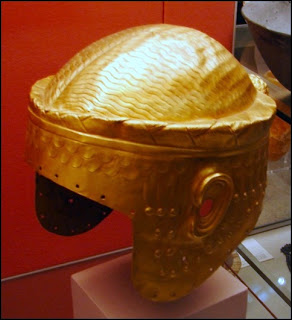
The
image above is that of a royal's helmet from the city of Ur, dating to
about 4,500 years ago. It shows the typical royal (kingly) headware of the time,
with a braided band and diadem wrapped around the head at temple
height. What one gets from this
image
is how thick the band was, and how
constrictive it must have been
to wear.

The Saudi Arabian people still wear traditional dress, with males –
including royal
rulers –
preferring
a band around the head to secure their
headcloths.
Historically, such headbands have been symbols related to painful
restriction around the head at birth. And this rulership is,
interestingly
enough, also known for being
socially
restrictive. It
is a male-dominated society with pre-teen brides, polygamy, religious
police, and women required by law to wear
whole-body-covering
clothing in public. [4] This
demonstrates
how unconscious, unresolved past traumas can be at work behind the
scenes of a skewed social system.
History
of Birth
Trauma in Science
Science is the specialist area of study that tries to find cures for
aspects of human suffering. But in this quest,
it, too, displays a history of birth trauma affecting (intruding into)
its work. In some treatments for head-based problems we can see a
continuation from primitive
times. For example, calming people down with electroshock therapy has
much the same thinking behind it as primitive blows to the head to
"knock some sense
into people". And brain
surgery
to quieten an overactive brain (as for Multiple
Sclerosis), is a progression from primitive trepanation,
that was used to free "demons" from inside the head. But also in
science there are familiar symbols of
unresolved crowning pain.
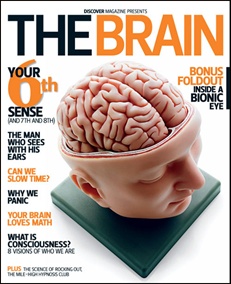
The above image is the cover of the 2011 special edition of
Discover
magazine, entitled "The Brain". [5]
It shows a head with its skull removed
from temple height
upwards, to expose the brain within (as this issue's subject of study).
(A similar
image – with both skull and
brain cut off at temple height – can
also be found illustrating science articles.) In essence, in its study
of the brain and mind, science is employing imagery that is reminiscent
of imagery that is thousands of years old (e.g., the
Ur helmet above). This begs the
question of how up-to-date is science's research into mental health
problems.
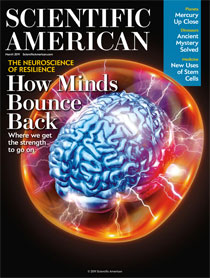
Now we come to the science magazine's birth trauma-like image
mentioned earlier. On the cover of the March 2011 issue of Scientific
American (Sciam)
magazine, there was an image representing how
the
troubles of daily life affect people. [6]
The image was composed of a brain
circumvented by a reddish tube (at temple height), with lightening
bolts jarring between the two. It was designed to convey how modern
problems impact on our brains, and cause us worries and concerns and
tensions. But
what it really
(inadvertently) showed was how modern
problems act to trigger
deeper, unresolved pains such as birth trauma –
specifically, in this case, the sensation of a tight band around the
head due to crowning pain at birth. (And note the remarkable similarity
of
this image to the actual photos of crowning above.)
The image was associated
with the
lead article about how we recover
from adverse situations, entitled, "How
Minds Bounce Back: where we get the
strength to go on". But the
article
made no mention of birth trauma at all, and did not even refer to the
cover image. Its discussion of overcoming traumas referred only to
one “recent trauma” for each person (going back a few years at most),
and not to past traumas
(i.e., going back to teenagehood, childhood, and birth).
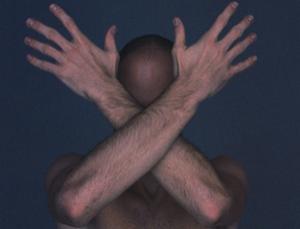
Another representation of suffering appeared in the 28 May issue of New
Scientist magazine. It was in an article entitled "Cross your
arms to relieve pain". [7] It
described an experiment in
which people were given a painful stimulus to one hand under two
situations: while the arms (and hands) were outstretched on a desk; and
then while
the arms were crossed on the desk. Those people who had their hands
crossed over to the other side of the body reported a lower sensation
of pain compared to those with hands straight out. But New Scientist
did not accompany this article with an image of crossed hands on a
desk; instead, it showed an image of a man, standing with bald head
bowed forward, arms crossed in front, and with the hand edges –
fingers spread – pressed against the temples. The image conveyed a
sense of torment. It was, in fact, a
symbolic crowning posture
– that
was largely unrelated to the article itself.
History
of Birth Trauma in Religion
Just as social leaders have a history of birth trauma-related headwear
to signify their status, and science has a history of birth
trauma-related head treatments and imagery, so, too, the religious
fraternity has
its own equivalent history.

Undoubtedly the most prominent symbol of birth trauma is the
Crown-of-Thorns. This was a form of ancient punishment, whose torturous
effect came from being able to trigger deeper head trauma from
birth. It seems tame to us today, but back then there were fewer mental
outlets for people, no headache tablets, or plentiful alcohol,
so the
Crown-of-Thorns was able to do an effective
torture job. It was also used as a punishment for Jesus, who people
claimed had promoted himself as the “King of the Jews”. Religious
people could have chosen any portrait of Jesus to follow, but they
particularly like to follow this type of a suffering
portrait.

A traditional practice employed by numerous religions has been to cut
off part or all of the hair. This is known as a tonsure.
It is a
mark of servitude and piety, which are deemed necessary qualities for
dedicated clerics. One tonsure example
is the type that is bald at the top with a ring of
hair at temple height, which forms a type of
crown (similar to that of the
Crown-of-Thorns). It is also directly symbolic of unresolved crowning
pain from birth.
Evidence
of Birth Trauma in Other Areas of Life
When society cannot resolve problems – like amorphous
suffering about the head – those problems tend
to be
expressed through various outlets: ranging from violence to creativity.
Two examples are shown below.

When it comes to warfare, guerrilla, and terrorist groups
– who
normally do not have uniforms – often go back to basics (and
back to human evolution) and don a standardised headband as
their insignia. Such a symbol unconsciously taps into unresolved birth
trauma to give added weight to their struggle.

In the
entertainment industry, unresolved traumas in the public can be
played-upon by film creators to provide a
"safe fright". For example, the horror movie franchise, Saw, has a victim
trap that is symbolic of birth struggle. It is the "Venus
Fly Trap", that can snap shut around the victim's head should they
fail to escape from it in time. This trap has a familiar theme of
tortuous imagery:
first, above, we had science's restrictive tube around the brain with
lightening
bolts, then religion's faux crown with a row of thorns, and now we have
entertainment's split, snap-shut, venus fly trap, with a row of nails
at temple height.
(These examples demonstrate the variety of applications employed for
birth trauma symbolism: to help explain suffering, be a means of
torture, or exploited
to entertain suffering people.)
All of the images shown here from different fields target that
unconscious band of pain around the
head circumference. Note
that because birth trauma is an unconscious
problem, that few people are ever shown escaping from
these
head traps: the Saudis continue to be stuck in a restrictive culture;
“overcoming”
traumas – as the Sciam
article promoted –
doesn't really work that well; Jesus didn't get free from his
predicament; Guerrillas and terrorists often end up dying for their
cause; and the guy in the
venus fly trap inevitably met a
gruesome end. The only people fortunate enough to truly escape from
such head-trauma related
restrictions are those who have reaccessed and resolved birth trauma.
The rest must endure a lifetime of trying to avoid suffering – via
bouts of frustration and rage, consumption of headache tablets, or use
of drugs and
alcohol. Notice
also how prevalent birth trauma (symbolism) is in our society,
and
has been for tens of thousands of years. Yet our ruling organisations
never talk about it, never
treat it, and even reject claims concerning it. This is precisely why
human
suffering continues in our species – because our ruling organisations
choose to ignore one of its main sources.
Representations
of the Superorganism, Fractal, or Hologram
A further image – relevant to the laws
of pain – appeared on the cover
of the May 2011 issue of Discover
magazine. [8]
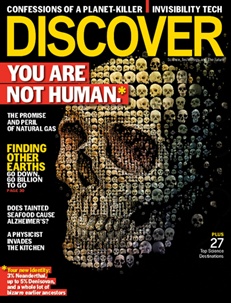
This image was of a human skull
made up of many smaller skulls. This is a typical way of representing
a hologram – or a fractal, or a superorganism.
It was associated
with an article entitled, "Homo Sapiens, Meet Your New Astounding
Family", which presented
several theories concerning a new family tree for our genus. But, as
with the Sciam birth-like
cover image and non-related article above,
there was no discussion within this article of our species as a
superorganism, nor even as a hologram, or fractal-like entity – not
even a mention of the terms. In this case the public is getting a mixed
message from science: the cover image says “human superorganism,
hologram, or fractal” while the article says “human family tree”. So is
the human species a superorganism – with a hologram, or fractal-like
structure? Or is it not a superorganism? If it is, then where is the
article describing it as such? If it isn't, then why is this magazine
visually portraying the species as such?
To use birth trauma and
superorganism-related imagery to spice-up
magazine articles – that do not refer to such images – means that there
are grounds for charges of false advertising, or misleading content
against science publications. Suffering people could see such images
and think that the magazines have new, pertinent information to help
them with deep, inexplicable, complex problems, only to find that the
associated content is just the usual theories – or small updates of
such – that do not further elucidate the human condition. Furthermore,
to use such imagery when mainstream science publicly denies the
existence of birth trauma – or that the human species is a
superorganism – is sheer hypocrisy.
Genetics-based
Research
When it comes to
genetics-based science, there was an interesting
study done on this in 2010. It was the tenth anniversary of the
genome
project, and Nature magazine
conducted a survey
of life scientists on its value. (Note:
this magazine is owned by Nature Publishing –
recognised as the most prestigious science publisher; and,
interestingly, it also owns
Scientific American – the
magazine that
had the birth-trauma-like cover image explained above.)
This is part of the poll's finding:
''With this profound new knowledge, humankind is on the
verge of
gaining immense, new power to heal. It will revolutionize the
diagnosis, prevention and treatment of most, if not all, human
diseases.' So declared then US President Bill Clinton in the East Room
of the White House on 26 June 2000...Ten years on, the hoped-for
revolution against human disease has not arrived — and Nature's poll of
more than 1,000 life scientists shows that most don't anticipate that
it will for decades to come...Although nearly 60% of those polled said
they thought that basic biological science had benefited significantly
from human genome sequences, only about 20% felt the same was true for
clinical medicine.' [9]
Medical research – including genetics, genomics, and now epigenetics –
costs a lot of money to fund. It produces
valuable information, has had some successes, but produces little in
terms of substantial, sustained healing. Most projects end with a
statement of expected beneficial treatments 5, 10, 20 or more years
into
the future – but rarely today.
Scientific research follows the principle of
peer review – which means that
submitted papers
are reviewed by similarly qualified scientists before being accepted
for publishing. This
works well when research follows accepted laws, principles, and
methodology; but it fails to
question any overarching "worldviews" – that
is, the way that nature may be perceived to work. For example, Nature's survey acted as a peer review of the
genetics theory (or worldview) of health and behavioural problems
– and
it failed dismally. Nature
should then have reassessed its attitude towards this type of research,
and
reduced its publishing of
it accordingly. It should also have begun looking for other laws or
theories (worldviews) to
publish health articles on. But it didn't. Nature,
and all the other science
publications, just continued to publish articles on genetics-based
research, as if
it was the only hope of investigating and treating health
and behavioural problems.
This is an hypocrisy that sees peer review as being mandatory on one
level, but being ignored on another level.
Cancer
Treatment
Cancer is a
prevalent disease – for which most forms have no cure –
that will strike many people at some point in their lives. Although
there are various disciplines involved in its study – like cell biology
and biochemistry – it, again, is mostly researched from the perspective
of genetic or epigenetic faults. And, again, medical science has failed
to find a solution to its problems – only prospects of cures in the
future (except for the cervical cancer vaccine, which has been a rare
success).
The laws of pain system,
however, provides a new perspective on cancer. According to it, the
behavior of
tumors is similar to the behaviour of superorganisms. Cancerous
cells firstly increase their
population. Clumps of cells then break off from the original tumor site
and travel through the body's (blood and
lymphatic)
transport
systems to establish colonies. There they wait dormantly until a
chemical
signal starts them invading tissue, hijacking blood vessels, and taking
nutrients away from the host to feed themselves (metastases). This
process is similar to superorganism behaviour, whereby a large empire
is created, scouts go off to establish colonies, and those colonies
then invade the local environment for food and raw materials. It is
also similar to how terrorist groups operate: utilising transport
routes to establish colonies (or terrorist “cells”); then wait for a
command to attack major targets; and generally cause mayhem and
destruction to their host society. And how does one stop a rampaging
superorganism? The method most commonly used in warfare is to “cut off
its head”, by killing its most prominent figures. The now leaderless
superorganism
tends to lose its malevolent motivation, and disintegrates. LOP
discussion of
superorganism behaviour
also extends to other species, like bees. In this case, showing that
specialised roles –
like queen bee and worker bee – are created by pain-laden behaviour,
thus disproving the traditional view that the roles are
genetically-determined.
From this new perspective, once again we can see science taking cues
from the laws of pain
(either
directly or through the grapevine) and
applying them back to traditional approaches. It has been known for
some time that stem cells are a driving force in some cancers. One new
theory has expanded on this phenomenon, by stating that
cancer metasteses are similar in kind to that of the queen bee and
hive
relationship. A queen bee builds up a hive from daughter offspring and
exerts control over them. Kill the queen bee and a hive can
disintegrate. Likewise, a colony of cancer cells is believed to develop
from a stem cell (AKA queen bee) and its daughter cells – since cancer
cell staining has shown that most come from the same parent stem cell.
So, kill the cancer stem cell/s and the cancer should likewise
disintegrate. [10] This
theory is similar to LOP's above – that cancers are
superorganism-like growths.
LOP discussion has also involved sugar craving. When a person resolves
a lot of past pain, they're need for sweet foods diminishes, and they
begin
to notice the large amount of sugar contained in human foods, like soft
drinks, flavoured milks, and cereals. This tells us that there is a
widespread degree of unresolved psychoemotional pain in our species –
leading to a mass sugar craving that is plied by food manufacturers.
Coincidentally, a number of science teams have described cancer cells
as
having a “sweet tooth”, in that they like to feed off sugar (sucrose).
If you take the sucrose away from them they will die. [11] This is similar
to the suffering of unresolved pain in the human species – except that
if you take sugar away from people they will suffer increased
irritability and tension, rather than dying.
Most of
the discussion in LOP concerns resolving tension. Unresolved pain is
accompanied by anxiety and tension, so resolving past
pain also reduces these symptoms and produces a calmer, more relaxed
disposition. Again, coincidentally, a number of science teams have
found that
a prevalence of tension (or stress) in mice increases the occurrence,
and
malignancy, of cancer. [12]
The latest study has shown that regular
intake of painkillers over the years significantly reduces the
incidence of (skin) cancer in the mice. So reducing tension and
"killing
pain" can both reduce the occurrence or severity of cancer.
Finally, with the laws of pain
it is noted that most
health problems that we suffer from are autoimmune-related.
The view here is that the internal pressure and rerouting of pain-laden
tension skews the functioning of the body, weakens the
immune system, and causes any of a variety of ailments. Conversely,
resolving past pain
strengthens the
immune system, because it
gradually heals ailments, like headaches, migraines,
ulcers, and acne,
for example. Again, coincidentally, studies have shown that the
anti-inflammatory
and painkiller, aspirin (asylicitic
acid) – which calms the autoimmune
response and subdues the sensation
of pain – can reduce tumors. So it is being recommended for use to
treat a
range of (autoimmune) symptoms, like high
blood pressure, stroke, heart disease, and cancer. [13]
So here we have four scientific
studies that describe cancer as
possessing the exact same attributes – superorganism behaviour, sugar
addiction, tension, and inflamed immune response – that the laws
of pain automatically heals in
suffering people, by resolving past traumas. What does this
tell us about
the nature of cancer? It tells us that the characteristic behaviour of
cancer cells is similar to the characteristic behaviour of humans who
suffer from unresolved trauma. Furthermore, that unresolved trauma can
fuel cancer – just like uncleared undergrowth can fuel a forest fire.
And, in
conclusion, that resolving past trauma can take away fuel from
potential cancerous growth – just like
clearing away undergrowth can take away fuel from a potential fire. And
if
such healed people do happen to get cancer, it is more likely to be of
the less virulent type, that will give them a better chance at
survival.
It is good that science performs detailed studies to try to find
drug solutions for health problems. But note, also, that studies like
those above are isolated efforts –
there is no coherent knowledge that pulls all the findings together;
and that there are no effective cures attained as yet for the problems
studied.
(Most cancer drugs are good at reducing tumor size, but not at healing
them.) Their most readily-available solution so far – that of the
painkiller aspirin – only has a temporary effect,
so one has to keep taking it to reduce symptoms and continue to
survive. Yet,
all those same study findings were already present in a law-based
solution – the LOP – showing
that it is indeed a science
that has an underlying unifying
nature, and an effective healing substrate. So the best scenario for
cancer sufferers would be
to have a hybrid approach of treatment – so that both ends of the
spectrum are covered: the
LOP to take fuel away from potential cancer growth; and medical science
to treat the cancer cells directly once people have got them.
Counter
Treatments, Articles, Theories, and Policies
In order to
address the
emergence of laws of pain
material on the Internet, religion, science, and government have
all begun promoting "counter" treatments, articles, theories, and
policies. Some examples follow.
After writing about exorcism being a practice similar to that used in
LOP treatment (but
using the wrong knowledge behind it), its
practice –
as well as
belief in evil – has since been
reaffirmed by religion. And, a new documentary, The
Exorcist in the 21st Century, was released to the public, as if
to
counter the LOP criticism that the practice is out of date in the
Twenty-first Century.
Numerous medical and psychological services are now making
counter claims to those discovered with the laws of pain.
They include being able to "rewire the brain", or
"increase ambidexterity", or to locate brain sites responsible for
one's
social outlook.
Although they may be able to achieve these things in various ways, such
results are not
attained naturally,
as a
result of healing the affliction (unresolved pain) that caused those
respective distortions in the first place.
Whenever an LOP article is posted on this site, it is
often the case that a science publication will publish a “counter
article” to it. This is an article on the same subject but from a
traditional perspective. For example, after I published the article
about “The Rosetta Stone of Postures...” an online science publication
posted an article about the real Rosetta Stone to counter it.
Whenever
an LOP blog is posted on this site, it is also often the
case
that the government will introduce a new policy or treatment program to
counter it. For example, when I blogged
about school shootings and the fact that government couldn't even
resolve
school bullying, the government introduced an anti-bullying program for
schools. When I blogged about Michael Jackson's death being similar to
other famous people –
who were given prescription medications to treat mental health problems
– the government immediately introduced a treatment program for
prescription drug addiction.
There are
numerous articles, books, and documentaries that laws of pain
science has
influenced, largely dealing
with human evolution, history, society, or entomology. They often
present a “new
perspective” on human nature, or involve a renewed interest in
superorganisms or in systems science.
But although such material does indeed present new findings, the
underlying worldview (involving human
evolution, social behaviour, and what makes us such a troubled species)
has largely
remained
unchanged.
One documentary
in particular is a case-in-point. Origins
of Us (2011) employs the latest
knowledge to try to explain the reasons for our species' evolution. [14] And
it actually mentions some developmental factors from the laws of pain. However, behind
these factors the LOP provides a single generating
source for human evolution: unresolved psychoemotional pain, that
repressed our natural ape qualities, and drove our species to develop
technologically. But this
documentary did not provide a generating source for human evolution –
just a string of
factors: standing
in trees to reach high food sources and walking upright on
land; meat-eating;
tool-making;
running to
hunt down prey; and extended
post-birth learning. And instead of
discussing pain endured by
babies at birth – as the LOP does – the documentary, instead, discussed
the pain
that a mother endures during labour and delivery. It is good that
scientists are finally recognising the effects of pain, but in this
case it is referenced to the wrong person. Adults have physical and
psychological strength to withstand pain – but babies do not, and so
their pain is stronger, more damaging, and has had a greater impact on
human evolution. The fact that traditional science cannot recognise any
pain that a baby might endure at birth – but can only substitute adult
pain instead – perfectly illustrates how unconscious our species is of
very early
trauma. And one must ask, if the mother experiences great pain at birth
– largely due to the oversized foetal skull emerging – wouldn't the
baby also suffer great pain from pressure to its soft skull?
These counter treatments, articles, theories, and policies are attempts
by
religion, science, and government to try to quash the laws of pain.
They are attempts to draw public attention away from them – as a new
approach to resolving human problems – and to keep their attention
focused on traditional knowledge and practices.
Options for
Action
Psychotherapeutic
and evolutionary evidence shows that
birth trauma places a lot of pressure on babies, and the partial
crushing of the skull can lead to a range of health and behavioural
problems. As
this article has
demonstrated, religion,
science, and government are aware of how a law-based system explains
human suffering. This
author has also made two approaches to government. In the mid 2000s, government was
informed
of the problems that ensue from pain caused to the head of babies at
birth. This was dismissed after referral to a
medical body. In 2012, a new category of medicine
– composed
of the LOP
and two other innovative
treatments
from other fields – was proposed.
This would not only
improve healing options for the public, but also potentially create
many
new jobs. But this, too, was
rejected.
Since
religion, science, and government are aware of a major
source of health and behavioural problems (in
birth trauma) –
but
have chosen to reject
or
ignore it – that now raises
the question of liability for damage
caused to people as a
result of not addressing that source. This
liability
includes failure to foster information to the public about the
problem, failure to foster information that could assist parents to
properly care (post-birth) for at-risk babies, failure to support
an effective
healing service for people who have been so affected, and continuing to
maintain an unfeeling-based culture. People could pursue the following means
of action.
- Families
with children who have suffered symptoms related to head trauma
at birth, could seek compensation for damage to those offspring.
- Victims
and their relatives of acts of mass violence – such as terrorism
and spree killings – could also seek
compensation for injuries or deaths. This is as a result of ruling
organisations allowing people
under their governorship to reach
adulthood in a psychoemotionally distorted state, thus
being able to inflict acts of mass violence against innocent people.
- The public
could also exercise their own choice of health policies at general
elections. They could avoid parties that want to maintain traditional
knowledge and practices, and vote instead for party/s that are prepared
to support a new healing revolution.
A New Human Right
to
address Psychoemotional Suffering
Every
social revolution brings with it a legal framework to help guide
society in the new direction from which it will benefit. The LOP's
legal framework is based on respecting a new human
right, as described below.
It is an
inherent human right that suffering be healed no matter how
or where it may occur – and to employ the most
effective knowledge and practices to do so. In line with this, people
have the right to live a life free of psychoemotional suffering. Such
suffering occurs from traumas accumulated throughout upbringing: from
pain at birth; poor parenting that lacks love, affection, and
interest; schooling that can have a bullying environment; and a
workplace that can have a dominant-subordinate management style. This
type of suffering can proliferate within an unfeeling culture that is
overseen by religion, science, and government (by maintaining
inaccurate or out-of-date doctrines, policies, laws, or actions/s).
Countries,
or social groups, that have significant rates of health problems and/or
distorted human
behaviours (like violence,
fanaticism, drug addiction, alcoholism, and
sex abuse) would
be considered
to have failed to meet this human
right. Such a
failing can be a serious problem because it is akin to allowing for
crimes
against humanity to be perpetrated by psychoemotionally distorted
individuals, and so it should be a failing that attracts measures
that would encourage change.
Questions that Religion, Science, and Government need
to Answer
Our ruling organisations are engaged in trying to suppress a new
science and practice – that of
the laws of pain – that can
heal the current crop of symptoms of human
suffering. They are doing this – not in a malicious way – but in
a way so as to prolong the prominence of
traditional knowledge and practices. Both religion and science have a
history of not questioning their prevailing worldviews, as well as
carrying on
practices for thousands of years past their use-by-date. For example,
Demonology
and exorcism, and the humors and bloodletting respectively. Meanwhile,
government supports
both religion and science as authoritative organisations, supports them
financially – in terms of tax breaks and grants respectively – and
recognises their roles in treating suffering in society. But since the
treatment of current health and behavioural problems has been below
par, and stuck firmly in
the past, these three organisations now need to answer some pertinent
questions.
Why do religion, science, and government employ laws of pain material to give a
boost to their own work, help explain their own views on suffering, or
to
develop health care policies respectively, when they publicly
ignore or refuse to accept that past traumas exist and can be
reaccessed and resolved?
Why does the government waste public funds on grants for needless,
shallow scientific research into psychoemotional illnesses? Especially
when they are conducted
by bodies that openly state that science does not exactly know what
causes such illnesses
(i.e., whether they are genetic, environmental, biochemical, or a mix
of
each).
Wouldn't it be more appropriate to cut back the
research
projects, and start financially supporting a law-based solution that
has already discovered what causes such
illnesses?
Why do government and science only allow cancer victims to be treated
from a limited range of scientific knowledge – mostly genetics-based?
And why, when those limited treatment approaches fail, do they expect
patients to just go home and wait to die? Why don't they offer cancer
victims the fullest range of knowledge available to tackle cancer, and
include a science on past pain resolution and superorganism behaviour –
especially when cancerous growths, themselves, behave like
superorganisms?
Regarding
genetics-based research, why are we giving so much support to a
(medical) science
that studies a part of
our being that has changed from our ape cousins by only about 6 percent
in 6 million years (the time when hominins split from chimpanzees)? And
it is not providing solutions to current problems – only promises of
cures in the future. In
contrast, laws of pain
science studies the brain – the
one part of our
being that has changed the most from our ape cousins – by
about 300
percent in 3 million years (the time when hominins left the ape
evolutionary path). It is the brain
that is bulging with suffering, not
the DNA code. And it is the brain that has an in-built healing
mechanism
– that is currently being blocked
from use
– not the DNA code.
The laws of
pain
already embodies this healing mechanism
(exfeeling) and can produce cures now – not at some
speculative future
time. We are wasting time and money – and people's lives – giving such
extensive support to a science that is looking in the wrong place.
Why do religion, science, and government all recognise that accident
victims with partially crushed skulls must be suffering great pain, and
will need health care to treat resultant headaches, migraines,
epilepsy, psychological problems, and/or outbursts of rage; yet, when
they witness partially
crushed skulls in babies during birth, they believe that it is
perfectly
natural, not painful, and that they do not need any special health
care? And then later on, they try to explain the same list of head
trauma-related
symptoms in ordinary people (those who have never had any head
accidents) to be
due to “evil demons”, “genetic faults”, or (in terms of rage) “lack of
education and discipline” respectively? Isn't it more likely to be true
that those same range of symptoms are a result of head trauma
occurring to ordinary
people when their skulls were partially crushed at birth?
And in finality, why do religion, science, and government just not want
babies to be able to free themselves from a lifetime of suffering – as
a result of
symptoms generated by pain that they endured at birth?
In the psychoemotionally ill, we have a potential bounty of healed,
rewired, and
re-energised brains that could tackle and find solutions for the worst
of our current social problems – such as overpopulation, global
warming, rising salt
table, overfishing, deforestation, and water shortages. But what are
religion, science, and government doing? They are lost in a morass of
shallow treatments that they all claim to work, yet the continued state
of human suffering clearly shows that they do not. Times change. New
challenges emerge. And our
ruling organisations need to adapt and change accordingly. Currently
they are not. When it comes to inexplicable symptoms of human suffering
– which mostly relate to mental health issues – we are not fully
living in a
sleek, modern Twenty-first
Century. Instead, we are still bound hand-and-foot to knowledge and
practices that were typical of the Stone Age.
References:
[1] WebMD, (online), WebMD, LLC., (accessed 27 Feb 2011),
http://www.webmd.com/migraines-headaches/tension-headaches
[2] The University of Tromsø, "Birth can reawaken the trauma of rape",
ScienceNordic.com, (online), ScienceNordic, Copenhagen, April 9, 2012,
(accessed 25 Nov 2012),
http://sciencenordic.com/birth-can-reawaken-trauma-rape
[3] Inside the Vatican,
National Geographic, (video), National Geographic Society, 2002,
http://shop.nationalgeographic.com/ngs/product/dvds/national-geographic-channel-dvds/people-and-places/inside-the-vatican-dvd
[4] "Saudi Arabia", Wikipedia, (online), Wikimedia Foundation, Inc.,
(accessed 18 Feb 2013)
https://en.wikipedia.org/wiki/Saudi
[5] "The Brain", 2011, Discover, (special issue), Kalmbach Publishing
Co., (accessed 30-03-12),
http://discovermagazine.com/2011/the-brain#.UQiTycjLdDE
http://cdn.media.discovermagazine.com/~/media/Images/Issue%20Covers/2012/SIPs/DS3_TheBrain.jpg?mw=231
[6] "Scientific American Magazine", March 2011 issue, Scientific
American,
(online), Scientific American, Inc., (accessed 20 Feb 2013),
https://www.scientificamerican.com/sciammag/?contents=2011-03
[7] "Cross
your arms to relieve pain", NewScientist, (online), Reed Business
Information Ltd., 29 May 2011, (accessed 30-03-12),
http://www.newscientist.com/article/mg21028145.000-cross-your-arms-to-relieve-pain.html
[8] "You are not Human", Discover May 2011, (online), Kalmbach
Publishing Co., (accessed 30-03-12),
http://discovermagazine.com/2011/may#.UQiTycjLdDE
Jill Neimark, "Homo Sapiens, Meet Your New Astounding Family", Discover
May 2011, (online), Kalmbach Publishing Co., Thursday, July 28, 2011,
(accessed 30-03-12),
http://discovermagazine.com/2011/may/25-homo-sapiens-meet-new-astounding-family#.UQiZ7sjLdDE
[9] "Human genome at ten: Science after the sequence", Nature,
(online),
Nature Publishing Group, 23 June 2010 | Nature 465, 1000-1001 (2010) |
doi:10.1038/4651000a, (accessed 1 Feb 2011),
http://www.nature.com/news/2010/100623/full/4651000a.html
http://www.nature.com/news/2010/100623/pdf/4651000a.pdf
[10] Safia
Danovi, "The queen in the hive – scientists find more evidence for
cancer stem cells", Science Update Blog, (online), Cancer Research UK,
August 3, 2012, (accessed 20 Feb 2013),
http://scienceblog.cancerresearchuk.org/2012/08/03/the-queen-in-the-hive-scientists-find-more-evidence-for-cancer-stem-cells/
[11] "Cancers' Sweet Tooth May Be Weakness", ScienceDaily, (online),
ScienceDaily LLC, Nov. 18, 2009, (accessed 20 Feb 2013),
http://www.sciencedaily.com/releases/2009/11/091118110658.htm
"Cancer's Sweet Tooth May Be Its Weak Link", ScienceDaily, (online),
ScienceDaily LLC, Nov. 17, 2011, (accessed 20 Feb 2013),
http://www.sciencedaily.com/releases/2011/11/111116143045.htm
Cancer’s Lack of Sweet Tooth Points to Therapeutic Target, GEN
magazine, (online), Genetic Engineering & Biotechnology News, Aug
24, 2012, (accessed 5 Feb 2013),
http://www.genengnews.com/gen-news-highlights/cancer-s-lack-of-sweet-tooth-points-to-therapeutic-target/81247227/
Judith Montminy or Misia Landau, "Attacking Cancer's Sweet Tooth Is
Effective Strategy Against Tumors", News Releases Harvard Medical
School Office of Public Affairs, (online), Harvard Medical School,
(accessed 20 Feb 2013),
http://web.med.harvard.edu/sites/RELEASES/html/6_29Leder_Fantin.html
[12]
Stephanie Pappas, "Anxious Mice Face Higher Cancer Risk", LiveScience,
(online), TechMediaNetwork.com, 25 April 2012, (accessed 12 Feb 2013),
http://www.livescience.com/19904-anxiety-cancer-risk.html
Vanessa Wasta, Stressed Mice Quicker To Get Skin Cancer, Johns Hopkins
Medicine, (online), The Johns Hopkins University, December 8, 2004,
(accessed 12 Feb 2013),
http://www.hopkinsmedicine.org/Press_releases/2004/12_08_04.html
[13] Aspirin: New Evidence Is Helping Explain Additional Health
Benefits and
Open Potential for New Uses, ScienceDaily, (online), ScienceDaily LLC,
Apr. 19, 2012, (accessed 28 Jan 2013),
http://www.sciencedaily.com/releases/2012/04/120419142932.htm
[14] Origins of Us,
(video), BBC2, BBC, Wed 19 Oct 2011, (broadcast on SBS Australia 2012),
http://www.bbc.co.uk/programmes/p00jjjw4
Febuary 2013
Previous
Home
Next
Text and/or
pictures
/ images / sound / video
� copyright Lane, R., 1997-present
Superpsychology LOP
All rights reserved










